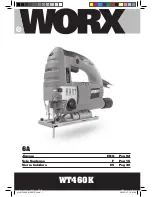
Jigsaw WT460K
long hair can be caught in moving parts. Keep handles dry, clean and free from oil and
grease. Rubber gloves and non-skid footwear are recommended when working outdoors.
c) Avoid accidental starting. Be sure switch is “OFF” before plugging in.
Carrying
tools with your finger on the switch or plugging in tools that have the switch “ON” invites
accidents. Do not use a tool if the power switch does not turn it “ON” and “OFF”.
d) Remove all adjusting keys and wrenches.
Make a habit of checking that adjusting
keys, wrenches, etc. are removed from the tool before turning it “ON”.
e) Do not overreach. Keep proper footing and balance at all times.
Proper footing and
balance enable better control of the tool in unexpected situations.
f) Use safety equipment. Always wear eye protection.
Dust mask, non-skid safety
shoes, hard hat, or hearing protection may be used for appropriate conditions.
g) Keep hands away from all cutting edges and moving parts.
h) If devices are provided for the connection of dust extraction and collection
facilities, ensure these are connected and properly used.
Use of these devices can
reduce dust-related hazards.
4. TOOL USE AND CARE
a) Use clamps or other practical way to secure and support the work-piece to a
stable platform.
Holding the work by hand or against your body is unstable and may lead
to loss of control.
b) Do not force tool. Use the correct tool for your application.
The correct tool will
do the job better and safer at the rate for which it is designed. Excessive force only causes
operator fatigue, increased wear and reduced control.
c) Do not use tool if switch does not turn it “ON” or “OFF”.
A tool that cannot be
controlled with the switch is dangerous and must be repaired.
d) Disconnect the tool from the power source before making any adjustments,
changing accessories, or storing the tool.
Such preventative safety measures reduce
the risk of starting the tool accidentally.
e) Store idle tools out of reach of children and other untrained persons.
Tools are
dangerous in the hands of untrained users.
f) Maintain tools with care. Keep cutting tools sharp and clean.
Properly maintained
tools, with sharp cutting edges, are less likely to bind and easier to control.
g) Check for misalignment or binding of moving parts, breakage of parts, and any
other condition that may affect the tool’s operation.
If damaged, have the tool
serviced before using.
Many accidents are caused by poorly maintained tools.
h) Use only accessories that are recommended by the manufacturer for your model.
Accessories that may be suitable for one tool may create a risk of injury when used on
another tool.
i) Use the right tool.
Do not force the tool or attachment to do a job for which it was not
designed.
5. SERVICE
a) Tool service must be performed only by qualified repair personnel.
Service or
maintenance performed by unqualified personnel could result in a risk of injury.
b) When servicing a tool, use only identical replacement parts. Follow instructions
in the Maintenance section of this manual.
Use of unauthorized parts or failure to
follow Maintenance Instructions may create a risk of electric shock or injury.
03
02
NA WT460K M 050727.indd 3
2005-7-27 18:01:40




































